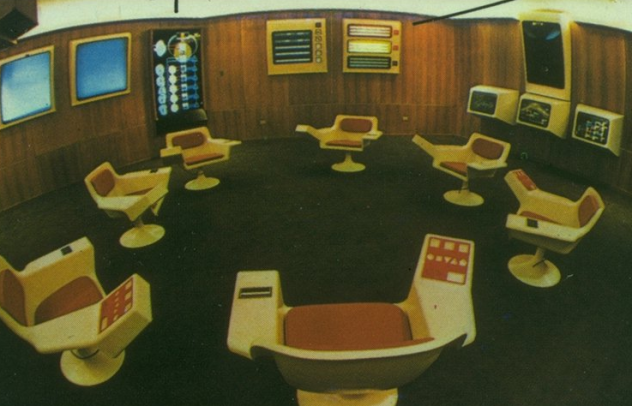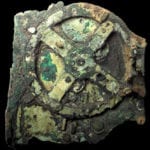 History
History  History
History  Technology
Technology Top 10 Everyday Tech Buzzwords That Hide a Darker Past
 Humans
Humans 10 Everyday Human Behaviors That Are Actually Survival Instincts
 Animals
Animals 10 Animals That Humiliated and Harmed Historical Leaders
 History
History 10 Most Influential Protests in Modern History
 Creepy
Creepy 10 More Representations of Death from Myth, Legend, and Folktale
 Technology
Technology 10 Scientific Breakthroughs of 2025 That’ll Change Everything
 Our World
Our World 10 Ways Icelandic Culture Makes Other Countries Look Boring
 Misconceptions
Misconceptions 10 Common Misconceptions About the Victorian Era
 Mysteries
Mysteries 10 Strange Unexplained Mysteries of 2025
 History
History 10 Things You Didn’t Know About the American National Anthem
 Technology
Technology Top 10 Everyday Tech Buzzwords That Hide a Darker Past
 Humans
Humans 10 Everyday Human Behaviors That Are Actually Survival Instincts
Who's Behind Listverse?

Jamie Frater
Head Editor
Jamie founded Listverse due to an insatiable desire to share fascinating, obscure, and bizarre facts. He has been a guest speaker on numerous national radio and television stations and is a five time published author.
More About Us Animals
Animals 10 Animals That Humiliated and Harmed Historical Leaders
 History
History 10 Most Influential Protests in Modern History
 Creepy
Creepy 10 More Representations of Death from Myth, Legend, and Folktale
 Technology
Technology 10 Scientific Breakthroughs of 2025 That’ll Change Everything
 Our World
Our World 10 Ways Icelandic Culture Makes Other Countries Look Boring
 Misconceptions
Misconceptions 10 Common Misconceptions About the Victorian Era
 Mysteries
Mysteries 10 Strange Unexplained Mysteries of 2025
10 Technological Systems Ahead Of Their Time
We often think of technological progress as the march from sparking fires with flint in caves to the inevitable rise of robot overlords, but it isn’t so simple. There are technological leaps, regressions, and cul-de-sacs throughout history. Sometimes a particular technology works, but it has arrived too soon.
10 Minitel
A forerunner to the modern Internet, Minitel was launched in France in 1982 and survived for 30 years. From small, tan-colored plastic terminals, users could check the phone directory, reserve train and theater tickets, browse news headlines, and enter chat rooms (including adult services). By 1985, the Minitel system was connected to over one million French homes. The number 3615, which Minitel used to access associated toll services, was once as ubiquitous in the French media as “www” is today.
In 1997, President Jacques Chirac boasted: “Today a baker in Aubervilliers knows perfectly how to check his bank account on the Minitel. Can the same be said of the baker in New York?” At its height, the system was installed in nine million homes, with an estimated 25 million users and 26,000 services offered.
However, the technology, while revolutionary at the time, had serious limitations. The terminals could only be used to call up specific, official addresses, there was no search function, and the terminal could not store or analyze information. It was also relatively expensive, though some services like the phone book were free. Some of the most expensive were hot-chat adult services, usually staffed by male employees of Minitel erotic services companies paid to moonlight as aroused women. Many of the Minitel’s functions were soon to be subsumed by the more flexible Internet.
However, there were still 810,000 Minitel terminals connected in 2012 when the system was finally shut down, and many older people were resistant to giving it up. One enthusiast explained his love for the system to the Independent: “You don’t get the clouds of useless information that you get on the internet. There is no risk of viruses or fraud. It was a remarkable invention.”
9 Morgantown PRT
In the 1960s and 1970s, there were many proposals to build personal rapid transit (PRT) systems, where riders could hop into small cars and be taken directly to their destination without stopping in between. Though the concept was sound, it was often difficult to get funding for the revolutionary transport technology. One of the first working examples was built in Morgantown, West Virginia, in 1975 as a transportation research project. It was funded by the federal government and developed by Boeing.
It runs between the campus of West Virginia University and downtown Morgantown, carrying 15,000 passengers a day during the fall and spring semesters. The system features 71 self-propelled carts moving at up to 48 kilometers per hour (30 mph) on a 14-kilometer (8.7 mi) track and is said to have helped to vastly increase enrollment at WVU. Prior to the system’s development, the university had to rely on an inefficient system of shuttle buses, and students were even banned from taking classes at different campuses, as there was no reliable way to get between them during the break period.
The research grant encouraged the development of the PRT as a showcase for the technology, with a number of technical innovations poured into it as development went forward. Today, the Morgantown PRT has become a safe and reliable part of the city’s infrastructure, helping to relieve traffic congestion. PRT networks have been developed in the Netherlands, Abu Dhabi, the United Kingdom, and South Korea.
8 QUBE
In the 1970s, Ohio Warner Cable constructed an experimental two-way cable system called QUBE in Columbus. It featured an interactive remote-control system through which viewers could use an 18-button, book-sized control box tethered to their televisions by a cable to vote on different topics, share their opinions, answer quizzes, and order individual pay-per-view movies and adult films. The system was completely revolutionary at the time, garnering significant interest from other television stations.
Most of the programming was local or imported from stations in Indianapolis, Cleveland, Cincinnati, and Athens, with 30 channels overall, including 10 pay-per-view channels. The QUBE system was one of the first to allow viewers to give their responses to what they are watching, such as presidential debates. QUBE was also capable of “narrowcasting” in order to provide educational material to specific subscribers.
The system was launched with great fanfare in 1977, with morning TV character Flippo the Clown descending from a helicopter while a high school band played “Jesus Christ Superstar.” On the first day of service, 10,000 initial subscribers ejected an Elvis Presley impersonator from a talent show, bought a golf club from Governor James A. Rhodes in a charity auction, and chose items to be placed in a time capsule. Though popular with residents and cable enthusiasts, the costs of the experimental network caused Warner to go into debt, and they eventually shelved the system after six years of operation.
7 SixDegrees.com

The first popular modern social networking site, SixDegrees.com was launched in 1997 and had up to one million members at its peak, though it’s virtually forgotten today. It was founded by financial analyst and legal professional Andrew Weinreich based on the idea that every person on Earth is only separated by six degrees. This was possibly based on the parlor game “Six Degrees of Kevin Bacon,” in which players attempt to connect other celebrities to Bacon via movie appearances with as few steps as possible.
The site was revolutionary for its time, featuring personal profiles, instant messaging, friends lists, and the ability to search other members’ friends lists. It allowed users to develop a web of contacts, send messages, and post bulletin board items to their first, second, and third degrees.
The problem for Weinreich was that monetizing social media was a task that the existing economic model of the 1990s could not support in the absence of an Internet advertising revenue stream. Financial losses and issues with proliferating spam forced Weinreich to close the site at the end of 2000 and sell it off to YouthStream Media Networks for $125 million. A revival was attempted in 2010, open to all previous members, but it failed to get off the ground, so SixDegrees.com finally disappeared from the Internet completely.
6 Sega Channel
Downloading games is a common feature in consoles these days, but the concept was around long before it actually became practical. Sega Channel was an early attempt to stream digital content to the Sega Mega Drive (called the Genesis in North America). As the Internet was still in its early stages, Sega collaborated with cable giants Time Warner Cable and TCI to deliver games over regular coaxial cable. Users would pay a $15 monthly fee (and $25 installation fee) to receive an adapter that fit into the console cartridge slot, which would give access to around 50 games, rotated and shuffled on a monthly basis. These could include catalog titles from SEGA, other third-party publishers, demos for upcoming games, and even access to games not available in the United States.
The SEGA channel sent a signal to the adapter allowing you to download games, which took a few minutes at most. However, each time you turned the console off, the content was wiped. Noise on the coaxial cables caused downloads to terminate, forcing the cable companies to take steps to clean up the signal, which became part of the drive for digital cable systems.
At its height, Sega Channel had 250,000 subscribers, but as Sega lost market share to Nintendo and put its weight behind the doomed Saturn system, Sega Channel became regarded as redundant and was ultimately shut down in 1998. The Galaxy 7 satellite, which transmitted the Sega Channel signal to cable operators across the US, spun out of geostationary orbit in 2000 and is now drifting wildly through orbital space.
5 Internet Talk Radio

Podcasting is now commonly enjoyed by millions, but it was once a new and unusual idea. Back in 1993, Carl Malamud launched the first foray with “Internet Talk Radio,” a weekly, 30- to 60-minute radio talk show broadcast on the Internet and downloaded through FTP. Each program was built around an interview with a particular individual of note within the computer network field, called the “Geek of the Week” segment.
An early hurdle was the fact that many home computers at the time were unequipped with sound and unable to handle the 64,000-bits-per-second data stream required to download the show. But computers at universities and businesses were in a better position, and innovations in home computing were just on the horizon.
At the time, some criticized the whole concept as a waste of precious network bandwidth, since the average show came in at a “whopping 30 megabytes of disk space.” Malamud would defend the concept as being a new and flexible media form, which people could download and listen to whenever they liked. For those who couldn’t afford the bandwidth, the show could also be subscribed to via cassette tape.
As a proof of concept, though, ITR helped to launch a revolution in audio publishing through the Internet. In one of the first music concerts performed online, Rolling Stones front man Mick Jagger greeted the audience: “I wanna say a special welcome to everyone that’s, uh, climbed into the Internet tonight . . . ” Many of these early broadcasts have been archived and can still be enjoyed today.
4 SPOT Watches
In 2004, Microsoft announced SPOT, standing for Smart Personal Object Technology. It was the first attempt to create a smartwatch, using FM signals to receive news, weather, stocks, the calendar, downloadable watch faces, sports, daily diversions, horoscopes, and lottery results. You could receive messages through the watch from MSN Messenger but couldn’t reply.
Suunto, Fossil, Tissot, and Swatch offered SPOT-capable wristwatches, which weren’t cheap, along with a Microsoft SPOT service costing $39.95 per year or $9.95 per month, plus tax. They were easy to activate with a credit card and Internet access but were bulky and required frequent charging. They were also only available in the United States and only covered 100 metropolitan locations.
The use of FM was also an example of poor timing, as cellular broadband was just starting to get off the ground. The SPOT watches were discontinued in 2008, but existing customers were able to continue to use them through the MSN Direct Service. While companies like Samsung and Apple currently develop more advanced smartwatches, many people have looked back on SPOT watches with a positive eye, saying that much of what went right and wrong with Microsoft’s effort helped to pave the way for the smartwatches of the next generation.
3 Dynavert

This Canadian experimental aircraft, known as the Canadair CL-84, or “Dynavert,” was developed between 1958–63 as one of the first V/STOL (Vertical Short Take-Off & Landing) close-support/utility transport aircraft ever created. It could tilt and lift its wings 90 degrees and was able to land, take off, hover, and maneuver like a helicopter. It had a simple control system largely resembling a normal, fixed-wing plane, except for the wing tilt function, and had smooth maneuverability.
It represented a number of significant aviation innovations, such as a large chord wing which was to be immersed in the propeller slipstream, large propellers on a pair of power plants, engines and rotors connected together by intricate shafts and gear boxes, and a stability augmentation system to reduce pilot workload at low speeds. Canadair’s analog computer facility and a cockpit mockup were even used to develop an effective flight simulation system.
One prototype and three developed versions were built for the Royal Canadian Air Force. Over 700 flights were made after the first in 1965. Dynavert proved to be a highly workable concept aircraft, with potential applications such as reconnaissance and surveillance, casualty evacuation, search and rescue, and city-to-city transport. Military tests of the aircraft included dropping of external stores, mini-gun firing, simulated rescues, use of a cargo sling, joint operations with a helicopter at seas, and hover downwash tests.
Unluckily, the first prototype was lost in a reliability test in 1967, with both pilots ejecting safely. Testing would continue until 1974, but neither the Canadian nor US government expressed enough interest in bringing the Dynavert to full production. The later-developed V-22 Osprey VTOL aircraft would ultimately bear a striking resemblance to its Canadian forebear.
2 Early Television
Television only really took off in the 1950s, but there were attempts to get things started much earlier. The earliest television sets were mechanical televisions, which relied on spinning discs with holes for their function. Light was shone through the holes of the spinning discs, hitting a sensor which captured the pattern of the image being filmed, which was then transmitted to a receiver via radio waves to reproduce the signals through similar spinning discs.
The technology was developed in England in the 1920s. Mechanical television stations were active for a few years in the early 1930s in the United States but were off the air by 1933, though they hung on longer in Europe. Mechanical television suffered from poor resolution, noise, and a somewhat harrowing viewing experience.
Mechanical television lost out to electronic television, which enjoyed superior fidelity and resolution and didn’t feature spinning discs of death that were prone to flying off the machine. Electronic television pictures were displayed on a cathode ray tube 23- to 30-centimeters (9–12 in) in diameter with a blue-white tinge. Electronic television was introduced to the United States at the 1939 World’s Fair in New York, with regular programming launched soon after.
Electronic television was also broadcast in the United Kingdom, France, Germany, and the Soviet Union. Development of the technology was put on hold by the outbreak of World War II. Production of TV sets ceased in the US and UK, though some broadcasting still continued.
1 Project Cybersyn

In the 1950s and 1960s, thinkers in the Soviet Union speculated on the development of a national computer network in order to help manage the socialist economy. This burgeoning science was known as economic cybernetics, promoting the concept of using an automated computer network to further the construction of the material and technical basis of communism.
Although they caused significant concern in the West, the dreams of the Soviet cyberneticians never came to fruition, due in part to technical obstacles like the lack of reliable peripherals and modems, poor telephone line quality, and a weak software industry. Political issues, like the conflict between the relative liberalism of the cyberneticians versus the central government’s greater concern with order and control, also caused problems.
Economic cybernetics did get off the ground in one unlikely place—Chile. In the 1970s, the radical Marxist government of Salvador Allende employed an eccentric British scientist named Stafford Beer to embark on a bold scientific experiment called Project Cybersyn (for “cybernetics synergy”). The idea was to create an electronic “nervous system” for Chilean society through an interactive national communications network allowing the public to express their feelings and opinions to the government.
The system featured a futuristic, hexagonal operations room where operators could sit on white, fiberglass swivel chairs complete with orange cushions, drink holders, and ashtrays. They could then view the Datafeed, giving summaries of economic information gleaned from factory data across the country. One wall was dedicated to Project Cyberfolk, a system that Beer developed to allow Chilean citizens to indicate their happiness levels with government decisions. From their homes, citizens could use a voltmeter-like dial device called an algedonic meter to indicate their level of happiness with government policy, ranging from extreme unhappiness to bliss.
The project was ultimately hampered by internal frictions, while the economic sanctions placed on Chile by other countries such as the United States led to the right-wing coup under Pinochet. The Chilean military found the egalitarian aspects of the Project Cybersyn unattractive, and planned to reintroduce the market economy anyway, so they destroyed it. Some see Project Cybersyn as a precursor to the power of Big Data in the modern economy.
David Tormsen is also a technological system ahead of his time. Email him at [email protected].








